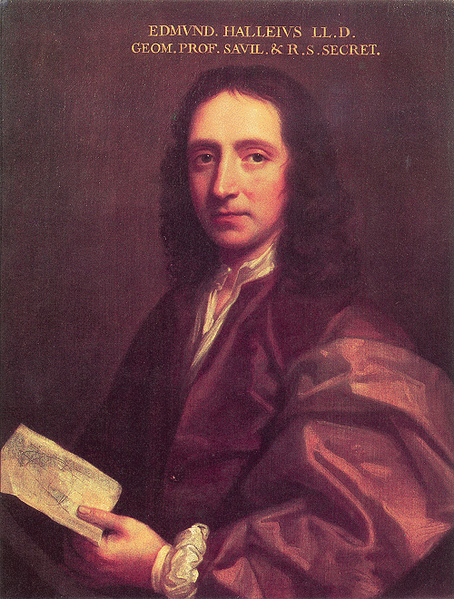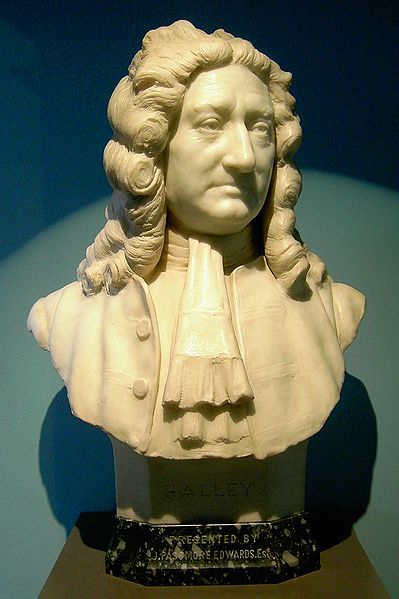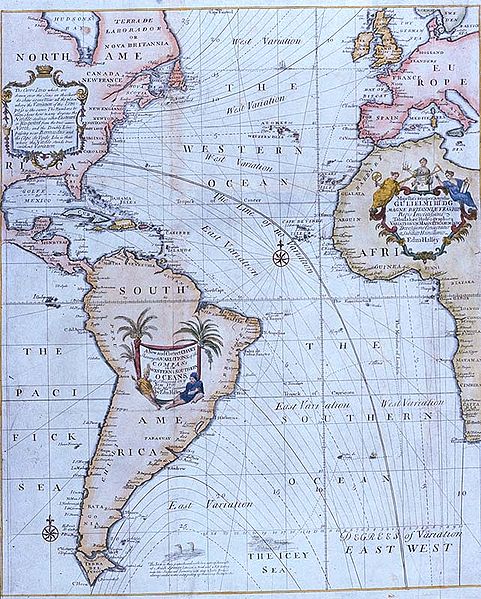<Back to Index>
- Astronomer Edmond Halley, 1656
- Composer Friedrich Wilhelm Michael Kalkbrenner, 1785
- King of Siam Rama VII, 1893
PAGE SPONSOR



Edmond Halley FRS (8 November 1656 – 14 January 1742) was an English astronomer, geophysicist, mathematician, meteorologist, and physicist who is best known for computing the orbit of the eponymous Halley's comet. He was the second Astronomer Royal in Britain, following in the footsteps of John Flamsteed.
Halley was born in Haggerston, Shoreditch, England. His father, Edmond Halley Sr., came from a Derbyshire family and was a wealthy soap - maker in London. As a child, Halley was very interested in mathematics. He studied at St Paul's School, and then, from 1673, at The Queen's College, Oxford. While an undergraduate, Halley published papers on the solar system and sunspots.
On leaving Oxford, in 1676, Halley visited the south Atlantic island of Saint Helena and set up an observatory with a 24 foot long (7.3 m) aerial telescope with the intention of studying stars from the Southern Hemisphere. He returned to England in November 1678. In the following year he went to Danzig (Gdańsk) on behalf of the Royal Society to help resolve a dispute. Because astronomer Johannes Hevelius did not use a telescope, his observations had been questioned by Robert Hooke. Halley stayed with Hevelius and he observed and verified the quality of Hevelius' observations. The same year, Halley published Catalogus Stellarum Australium which included details of 341 southern stars. These additions to present day star maps earned him comparison with Tycho Brahe. Halley was awarded his M.A. degree at Oxford and elected as a Fellow of the Royal Society.
In 1686 Halley published the second part of the results from his Helenian expedition, being a paper and chart on trade winds and monsoons. In this he identified solar heating as the cause of atmospheric motions. He also established the relationship between barometric pressure and height above sea level. His charts were an important contribution to the emerging field of information visualization.
Halley married Mary Tooke in 1682 and settled in Islington. The couple had three children. He spent most of his time on lunar observations, but was also interested in the problems of gravity. One problem that attracted his attention was the proof of Kepler's laws of planetary motion. In August 1684 he went to Cambridge to discuss this with Sir Isaac Newton, only to find that Newton had solved the problem, but published nothing. Halley convinced him to write the Principia Mathematica Philosophiae Naturalis (1687), which was published at Halley's expense.
In 1691, Halley built a diving bell, a device in which the atmosphere was replenished by way of weighted barrels of air sent down from the surface. In a demonstration, Halley and five companions dived to 60 feet in the River Thames, and remained there for over an hour and a half. Halley's bell was of little use for practical salvage work, as it was very heavy, but he made improvements to it over time, later extending his underwater exposure time to over 4 hours. Halley suffered one of the earliest recorded cases of middle ear barotrauma. That same year, at a meeting of the Royal Society, Halley introduced a rudimentary working model of a magnetic compass using a liquid filled housing to damp the swing and wobble of the magnetized needle.
In 1691 Halley sought the post of Savilian Professor of Astronomy at Oxford, but, due to his well known atheism, was opposed by the Archbishop of Canterbury, John Tillotson and Bishop Stillingfleet. The post went instead to David Gregory, who had the support of Isaac Newton.
In 1692, Halley put forth the idea of a hollow Earth consisting of a shell about 500 miles (800 km) thick, two inner concentric shells and an innermost core, about the diameters of the planets Venus, Mars, and Mercury. He suggested that atmospheres separated these shells, and that each shell had its own magnetic poles, with each sphere rotating at a different speed. Halley proposed this scheme in order to explain anomalous compass readings. He envisaged each inner region as having an atmosphere and being luminous (and possibly inhabited), and speculated that escaping gas caused the Aurora Borealis.
In 1693 Halley published an article on life annuities, which featured an analysis of age - at - death on the basis of the Breslau statistics Caspar Neumann had
been able to provide. This article allowed the British government to
sell life annuities at an appropriate price based on the age of the
purchaser. Halley's work strongly influenced the development of actuarial science. The construction of the life - table for Breslau, which followed more primitive work by John Graunt, is now seen as a major event in the history of demography. In 1698, Halley was given the command of the Paramour, a 52 foot pink, so that he could carry out investigations in the South Atlantic into the laws governing the variation of the compass.
On 19 August 1698, he took command of the ship and, in November 1698,
sailed on what was the first purely scientific voyage by an English
naval vessel. Unfortunately problems of insubordination arose, allegedly by officers resentful of being under a civilian's command. The Paramour returned to England in July 1699. Halley thereupon received a commission as a temporary Captain in the Royal Navy, recommissioned the Paramour on 24 August 1699 and sailed again in September 1699 to make extensive observations on the conditions of terrestrial magnetism.
This task he accomplished in a second Atlantic voyage which lasted
until 6 September 1700, and extended from 52 degrees north to 52
degrees south. The results were published in General Chart of the Variation of the Compass (1701). This was the first such chart to be published and the first on which isogonic, or Halleyan, lines appeared. The
preface to Awnsham and John Churchill’s collection of Voyage and
travels (1704), perhaps by John Locke or by Edmond Halley, made the
link. “Natural
and moral history is embellished with the most beneficial increase of
so many thousands of plants it had never before received, so many drugs
and spices, such unaccountable diversity. Trade is raised to highest
pitch, and this not in a niggard and scanty manner as when the
Venetians served all Europe … the empire of Europe is now extended to
the utmost bounds of the Earth.” In November 1703 Halley was appointed Savilian Professor of Geometry at the University of Oxford, his theological enemies, John Tillotson and Bishop Stillingfleet having died, and received an honorary degree of doctor of laws in 1710. In 1705, applying historical astronomy methods, he published Synopsis Astronomia Cometicae,
which stated his belief that the comet sightings of 1456, 1531, 1607,
and 1682 related to the same comet, which he predicted would return in
1758. Halley did not live to witness the comet's return, but when it
did, the comet became generally known as Halley's Comet. In 1716 Halley suggested a high precision measurement of the distance between the Earth and the Sun by timing the transit of Venus. In doing so he was following the method described by James Gregory in Optica Promota (in which the design of the Gregorian telescope is
also described). It is reasonable to assume Halley possessed and had
read this book given that the Gregorian design was the principal
telescope design used in astronomy in Halley's day. It is not to Halley's credit that he failed to acknowledge Gregory's priority in this matter. In 1718 he discovered the proper motion of the "fixed" stars by comparing his astrometric measurements with those given in Ptolemy's Almagest. Arcturus and Sirius were
two noted to have moved significantly, the latter having progressed 30
arc minutes (about the diameter of the moon) southwards in 1800 years. In 1720, together with his friend the antiquarian William Stukeley, Halley participated in the first attempt to scientifically date Stonehenge. Assuming that the monument had been laid out using a magnetic compass,
Stukeley and Halley attempted to calculate the perceived deviation
introducing corrections from existing magnetic records, and suggested
three dates (AD 920, AD 220 and 460 BC), the earliest being the one
accepted. These dates were wrong by thousands of years, but the idea
that scientific methods could be used to date ancient monuments was
revolutionary in its day. Halley succeeded John Flamsteed in 1720 as Astronomer Royal,
a position Halley held until his death in 1742 at the age of 85. Halley
was buried in the graveyard of the old church of St. Margaret, Lee (now ruined). In the same vault is Astronomer Royal John Pond; the unmarked grave of Astronomer Royal Nathaniel Bliss is nearby.